The Mexican peso is the official currency of Mexico. Its symbol is $, the same (as well as earlier in time) than that of the American dollar and its origins date back to the beginning of the 20th century. The ISO code for the Mexican peso is MXN.
Compare rates at 103 currency stores in 34 cities (free service)
The peso ($) is divided into 100 cents (¢ symbol). The peso is the name of other world currencies such as the Argentine peso, Chilean peso, Colombian peso, Dominican peso, Philippine peso or the Uruguayan peso.
As of the date of this post (13th April 2023), the euro to peso exchange rate is as follows:
- one euro equals 19,97 pesos.
- 10 pesos are equivalent to 0.50 euros.
Origins of the Mexican peso
Before the mexican independence
Between the years 1535 and 1821, the time of the Viceroyalty of New Spain, which had its headquarters in Mexico City (formerly Tenochtitlan), the most common form of payment was exchange or barter because the Spanish hardly had coins (“castellanos”) that they brought with them. One of the most valued merchandise at that time was cocoa, along with jade beads and cotton blankets.
The “conquistadores” obtained large quantities of gold and silver from the Indians and prospected for precious metals in numerous Mexican mines.
Compare rates at 103 currency stores in 34 cities (free service)
Thanks to this abundance of gold extracted from the American countries, it allowed the Spaniards to produce metallic gold, silver and copper coins for use among the colonial population.
Originally the coins were made by hand, melting discs of an alloy of gold and copper (pesos de tepuzque), with the same weight as the “castellano”.
It is because of this Spanish-local currency equivalence that it became customary to call the monetary unit of Mexico and many other Latin American countries, the peso (“peso” in Spanish means “weight”).
Coins referenced to their weight in precious metal
The face value of these coins was that of their weight in the metal they were made of (remember the popular expression, “worth their weight in gold”).
This allowed them to be accepted as a means of payment since their face value was referenced to their precious metal content. that is, that money was a commodity with intrinsic value.
Paper banknotes
For this same reason, in those years, the adoption of banknotes by these Spanish colonies in Central and South America was timid and slow.
There were some issues of paper banknotes, issued by private banks as voluntary purchase credit titles and payable in legal currency. The holder of one of these securities could exchange it for coins when it was agreed.
Later it was the colonial government that issued notes of legal tender of obligatory use and acceptance, also convertible or exchangeable for metallic currency made of precious metals.
Finally, the currency began to be produced with all kinds of low-value metals, becoming fiduciary currency (“fiat”).
Mint of Mexico
In 1535, Viceroy Don Antonio de Mendoza received the certificate from King Carlos I and King Juana La Loca for the founding of the Casa de Moneda de México, the first of its kind in all of America.
The first coins minted in Mexican territory were known as “Carlos” and “Juana” due to the Latin inscription on their obverse (Carolus et Iohana).
Globalization of the American currency
During the reign of Philip II (1556-1598), the “return route from the Philippines to the port of Acapulco” was discovered (1565).
This created an important trade route between the Americas and the Orient, with the currencies produced in Mexico ruling practically all world trade (hence the name of the Philippine peso).
The coin produced at this time is known as a “macuquina” coin (perhaps from the Arabic macuch, meaning “approved” or “sanctioned”).
During the 18th century, silver coins called “columnarios” or “of worlds and seas” were minted in Mexico, representing the two worlds with the Latin legend “Vtraque vnum” (both are one).
These Mexican coins were the main means of international payment at the time and were known as “peluconas” as they showed the effigy of the king in armor and abundant wig from the Age of Enlightenment.
After Mexico´s independence
The War of Independence from Spain (1810-1821) involved the looting by bandits of the silver transported to the Mexican Mint to be minted.
This, along with the occupation of the mines and the export of current coins, gave way to the issuance of coins by the insurgents, in copper, as “promises to pay.”
This represented the introduction in Mexico of a fiduciary currency without intrinsic value. The obverse of these crude pieces was the monogram of the Morelos insurgent together with the denomination and year of minting. Pieces of eight, two, one, and a half real were produced.
In 1823 Mexico, already as an independent Republic, President Guadalupe Victoria decreed the minting of gold and silver coins according to the Spanish octaval system in denominations of escudos and reales. But with different designs inspired by the symbols of freedom and justice of the French Revolution.
From the Monetary Reform of 1905, the gold standard was adopted, and the coins began to have the current inscription “United Mexican States”.
This reform created gold coins of ten and five pesos with a law of 900 thousandths which present, for the first time since the establishment of the Republic, the effigy of a historical figure: Miguel Hidalgo y Costilla.
In the last quarter of the 20th century, the value of the coins fell so much due to inflation that high denomination coins (one thousand and up to five thousand pesos) were minted.
On June 18, 1992, it was established that from 1993 a new unit of the Monetary System of the United Mexican States would be used, equivalent to 1000 pesos of the previous unit: the new Mexican peso “N$”.
In 1996 the adjective “New” (N$) was eliminated, issuing new coins with the same designs as the previous series but in denominations of 1, 2, 5, 10 pesos ($) and 5, 10, 20 and 50 cents.
Synonyms of the Mexican peso
In many parts of Mexico the peso is called with the following words also associated with the generic “money” (in Spanish): “varo”, “billullo”, “lana”, “marmaja”, “billeye”, “ribete”.
Mexican peso coins
The legal tender coins of the Mexican peso are these:
- 5, 10, 20 and 50 cents (¢), and
- 1, 2, 5, 10 pesos ($).
- 20 pesos (commemorative coin).
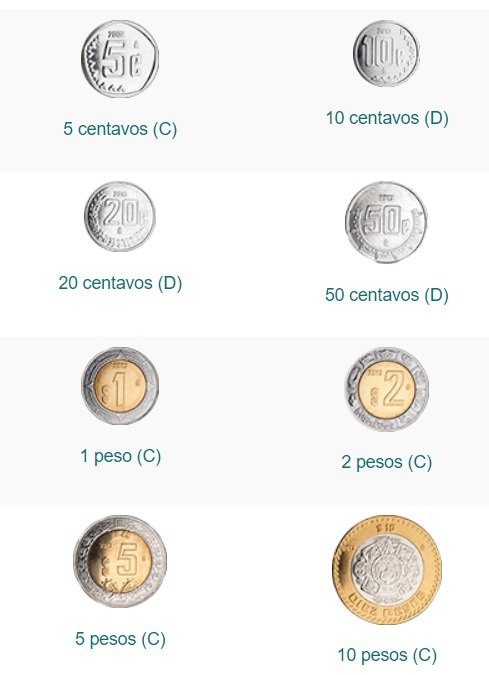
Mexican peso coins in circulation today
In winter 2019, the Bank of Mexico (Banxico) announced that it was going to mint a 20-peso coin while withdrawing the banknote of the same value from circulation.
The reason given is that the “paper” has an average life of about 40 months before being replaced by deteriorated, compared to the currency, which can last without being replaced, about 30 years, despite the fact that it costs more to issue than the banknote.
The new 20 Mexican pesos coin has a diameter of 30 mm and entered into circulation on September 27, 2021.
There are 3 commemorative variants of the 20 pesos coin.
- Of the 700 years of the lunar foundation of the city of Mexico-Tenochtitlan;
- Of the 500 years of historical memory of Mexico-Tenochtitlan;
- Of the bicentennial of National Independence,
This is the appearance of its obverse (same for all of them, it shows the National Shield in sculptural relief, with the legend “ESTADOS UNIDOS MEXICANOS” forming the upper semicircle):
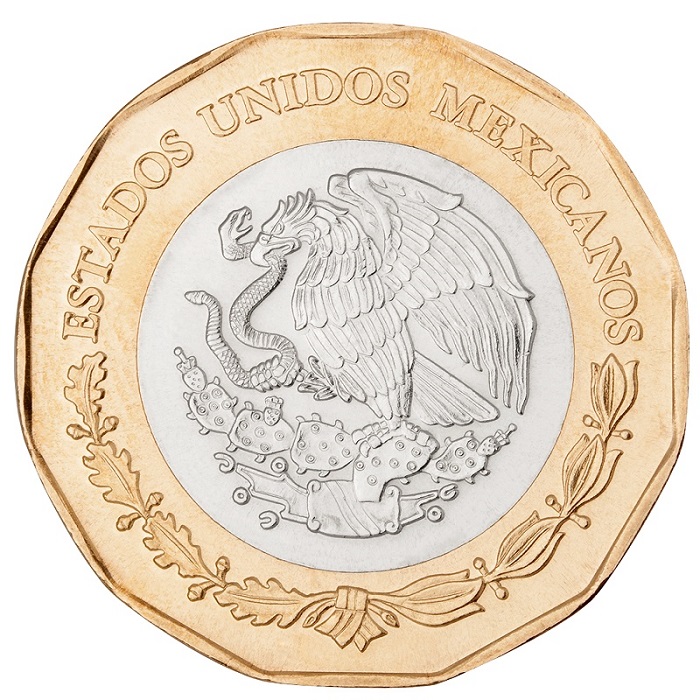
20 Mexican peso coin Obverse
And this is the back of the first one:
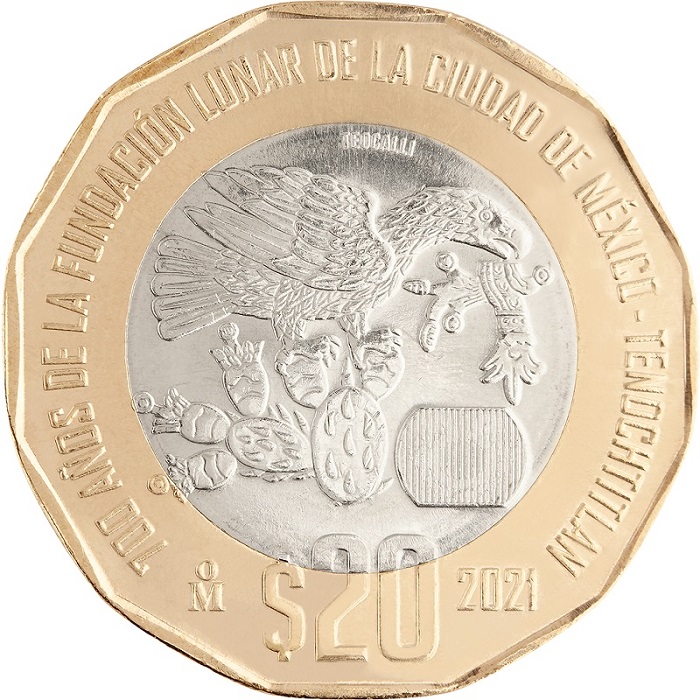
20 Mexican peso coin reverse
Mexican peso banknotes
Banco de México was born on September 1, 1925 with the power to mint coins and issue banknotes exclusively, regulate monetary circulation, interest rates and exchange rates.
The first Bank of Mexico notes were printed by the American Bank Note Company of New York (ABNC). In 1969, the Banco de México Banknote Factory began activities.
Currently, Mexican peso banknotes circulate in Mexico from the G series (started in 2013 and printed from 2017) with the denominations of $20, $50, $100, $200, $500 and $1000 pesos. Each of them represents a popular character and/or a popular monument:
- 20 pesos banknote: blue color. Benito Juárez and Monte Albán Archaeological Zone.
- 50 pesos banknote: pink. José Mª Morelos y Pavón. Morelia aqueduct.
- 100 pesos banknote: yellow/red Nezahhualcóyotl color. Greater Temple of Tenochtitlan.
- 200 pesos banknote: green color. Sor Juana Ines De La Cruz. Panoaya Farm (Amecameca).
- 500 pesos banknote: brown color. Diego Rivera. Frida Kahlo painting “The love embrace of the universe”.
- 1000 pesos banknote: purple color: Miguel Hidalgo y Costilla. University of Guanajuato.
The successive issues of banknotes by Banxico bear a name from a letter of the alphabet. The most recent are those of the G family, which corresponds to polymer banknotes.
Below we put the photos of the Mexican peso banknotes so that you can have them as a reference. They are taken from the website of the Bank of Mexico (Banxico).
20 peso banknote
Since September 24, 2021, this 20 Mexican pesos banknote has been in circulation, in green and red colors, measuring 120 x 65 mm and made of polymer. This banknote belongs to the G family of pesos banknotes.
It is a commemorative banknote of the Independence of Mexico (specifically the entry of the “Army of the three guarantees in the capital of Mexico on September 27 of the memorable year of 1821”.
This is what it looks like:
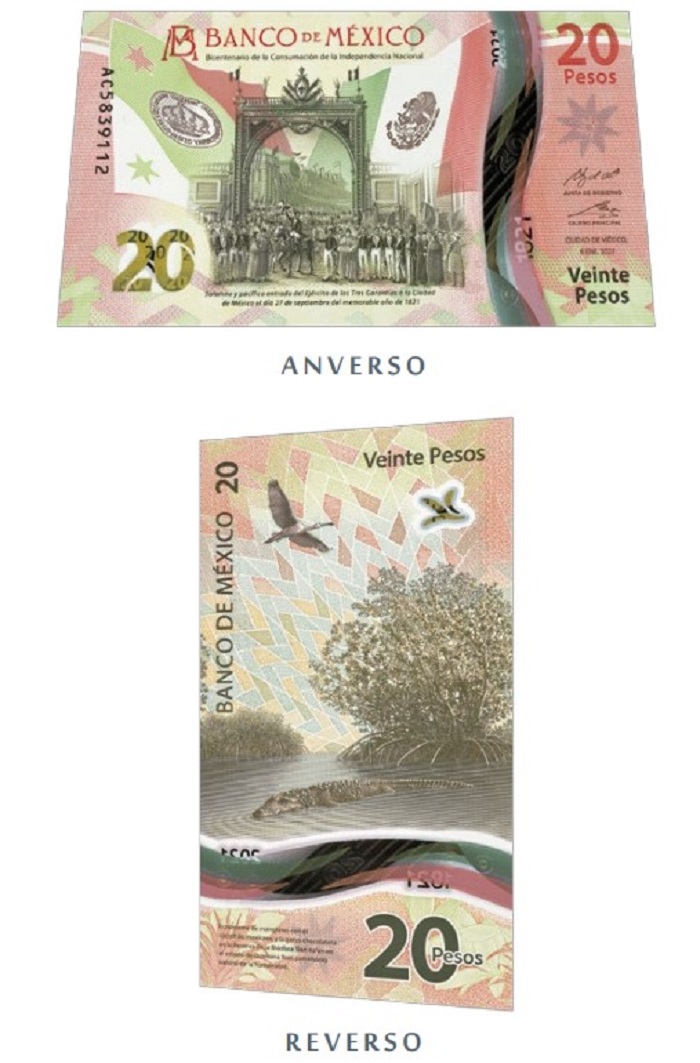
20 Mexican peso banknote
The equivalent value of this 20-peso banknote for exchange in euros, at currency suppliers in Spain today, 13th April 2023, would be about 84 euro cents.
50 peso banknote
Since October 28, 2021, the 50-peso banknote of the G family has been circulating in Mexico with a vertical design on the front and back.
On the obverse it shows an eagle perched on a cactus with the “Atl tlachinolli” in its beak and on the reverse a representation of the lake city of Tenochtitlan, based on part of Diego Rivera’s mural.
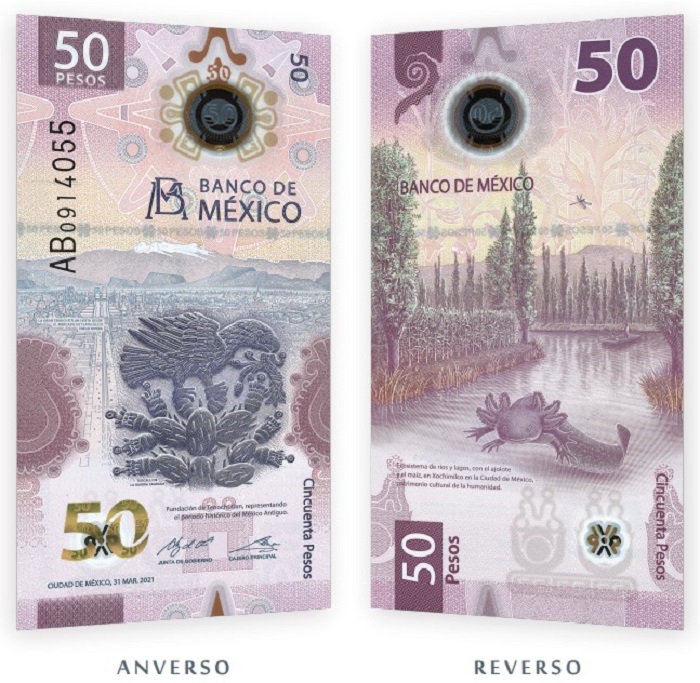
50 Mexican pesos banknote
The equivalent value of this 50-peso banknote for exchange in euros, in currency suppliers in Spain today, 13th April 2023, would be about 2.11 euros.
100 peso banknote
Since November 12, 2020, the 100-peso banknote of the G family has been circulating in Mexico with a vertical design on the front and back and a red color.
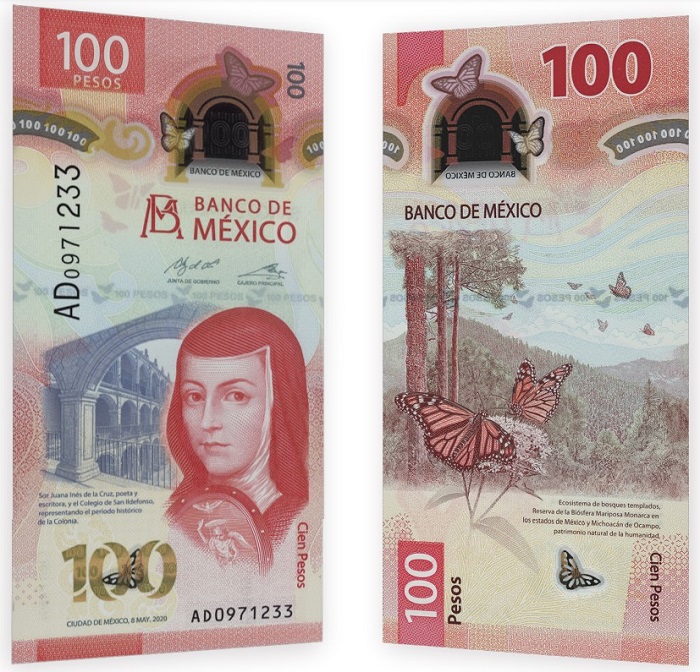
100 Mexican pesos banknote
On the obverse it shows a portrait of Sor Juana Inés de la Cruz next to a fragment of the main patio of the Antiguo Colegio de San Ildefonso, (Historical Center of Mexico City).
The reverse shows the temperate forests of the Monarch Butterfly Biosphere Reserve (Mexico and Michoacán de Ocampo states), and recognized by UNESCO as a natural heritage of humanity.
The equivalent value of this 100-peso banknote to exchange in euros, in currency suppliers in Spain today, 13th April 2023, would be about 4.22 euros.
200 peso banknote
Since September 2, 2019, the 200-peso banknote of the G family has been circulating in Mexico, inaugurated with the 500 MXN banknote.
This banknote replaces the banknote below dedicated to Sor Juana Inés de la Cruz, which now occupies the 100-peso banknote of the new G family.
On its obverse it shows the effigy of Miguel Hidalgo y Costilla (1753-1811) and José María Morelos (1765-1815), heroes of the independence of Mexico.
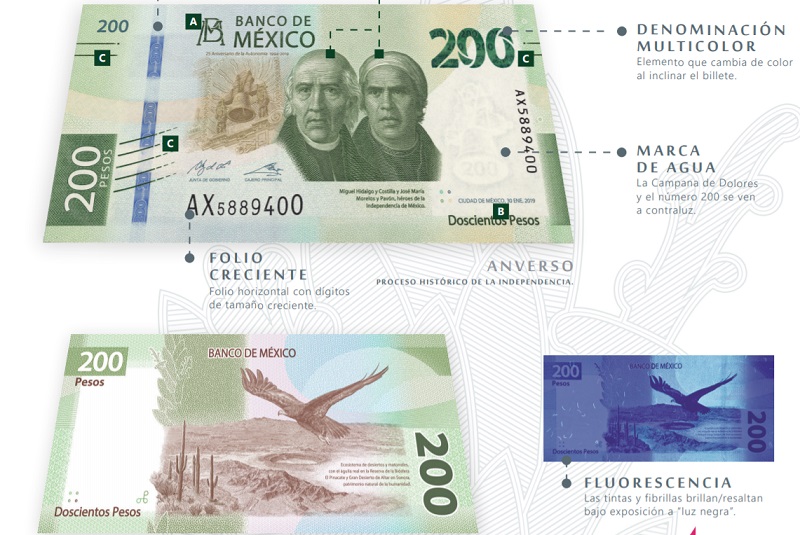
200 Mexican pesos banknote
Hidalgo is credited with the uprising against the Spanish under the “Cry of Dolores”, on September 16, 1810, when the bells of the city of Dolores, in Guanajuato, tolled to the sound of proclamations such as “Long live independence! long live America! or die the gachupines!” (Esquilón of San José). Morelos continued to fight to the death of Hidalgo.
On the back of the banknote, there is a snapshot of the El Pinacate Biosphere Reserve (in the state of Sonora) and the Gran Desierto de Altar representing the ecosystem of deserts and scrublands.
The equivalent value of this 200-peso banknote for exchange in euros, at currency suppliers in Spain today, 13th April 2023, would be about 8.44 euros.
500 peso banknote
This blue banknote was put into circulation in August 2018, and was the first to start the new series of Mexican banknotes, the G series.
It shows on the obverse the Reform and the restoration of the Republic with President Benito Juárez (1806-1872) triumphantly entering Mexico City on July 15, 1867, symbolizing the victory of the Reform, of the Church-State separation and of the basic principle of equality before the law.
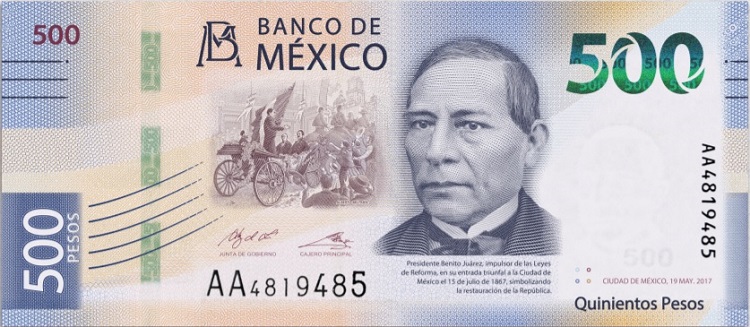
500 Mexican pesos banknote obverse
The reverse shows the ecosystem of coasts, seas and islands through a gray whale with its calf in the El Vizcaíno Biosphere Reserve, in Baja California Sur, recognized by UNESCO as a natural heritage of humanity.
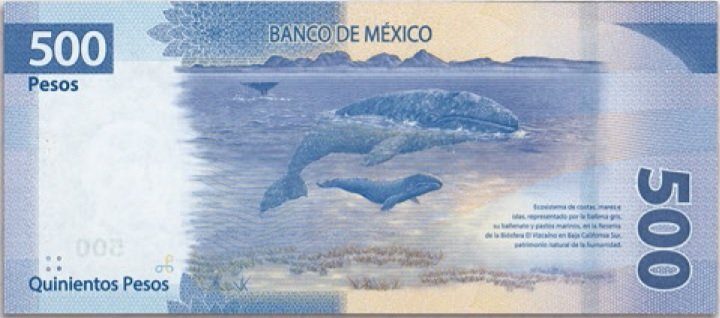
500 Mexican pesos banknote reverse
This 500-peso banknote has been nominated by the International Banknote Society (IBNS) as one of the best-designed banknotes in the world.
The equivalent value of this 500-peso banknote to exchange in euros, at currency suppliers in Spain today, 13th April 2023, would be about 21.10 euros.
1000 peso banknote
On November 19, 2020, the new 1000 peso banknote of the G family was launched, dedicated to the Mexican Revolution. It measures 153 x 65 mm, is made of cotton paper and its color is predominantly grey.
The obverse shows the image of a locomotive as a means of transport for the revolutionaries and the effigies of Francisco I. Madero, Hermila Galindo and Carmen Serdán, all of them promoters of the revolutionary ideals of democracy, equality and justice in the 19th century.
Francisco I Madero was a Mexican businessman and politician who rose up against the government of Porfirio Díaz, starting the Mexican Revolution of 1910. Carmen Serdán Alatriste was a Mexican revolutionary as was Hermila Galindo (known as Hermila Galindo de Topete).
The reverse shows the humid jungles in the Ancient Mayan City, a jaguar and protected tropical forests of Calakmul in Campeche, recognized by UNESCO as a natural and cultural heritage of humanity.
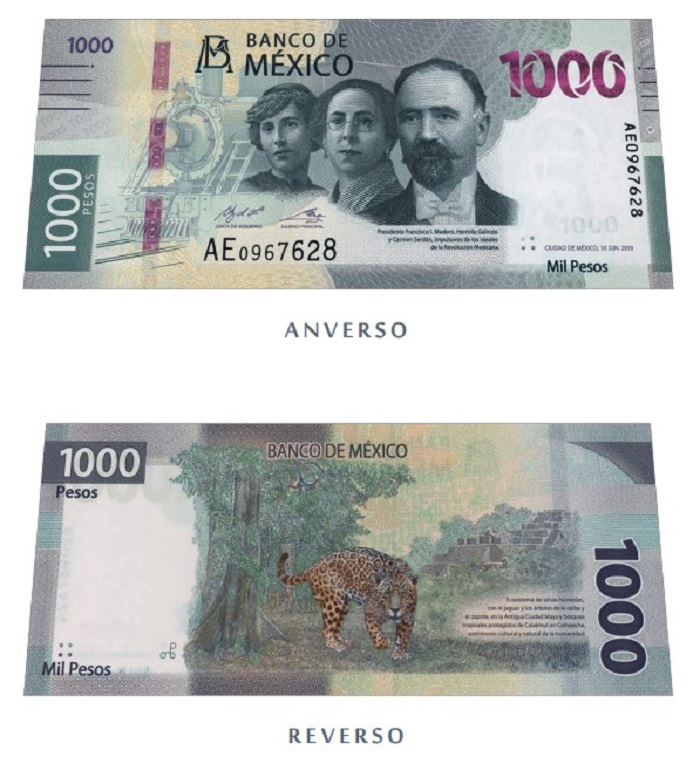
1000 Mexican pesos banknote
The equivalent value of this 1000-peso banknote to exchange in euros, in currency suppliers in Spain today, 13th April 2023, would be about 42.19 euros.
Mexican peso to euro exchange rate
The change of the euro with respect to the Mexican peso oscillates at all times. If you search on Google for “Euro to Mexican peso exchange rate” you will find dozens of websites like Oanda (“currency converters”) that offer a “rate” of the day, even with Google Finance rates.
Something like this (13th April 2023):
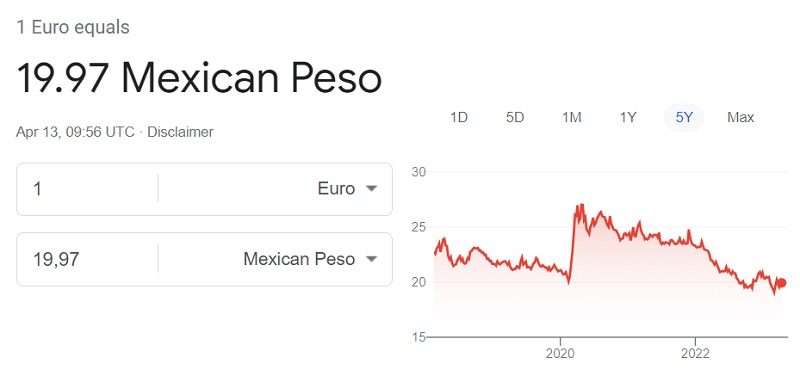
Euro to Mexican Peso exchange rate (13 April 2023)
As you can see, the change in the last 5 years has fluctuated between 19 and 27 pesos per euro, up to the current 20.72 euros of this update.
Currency is not paper money
But keep in mind that this graph represents the value of the “currency” against the euro, and not the currency, which is lower.
In fact, at currency suppliers in Spain you can buy Mexican pesos at an exchange rate of between 19.46 pesos per euro (today’s best rate) and 14.31 pesos per euro at the Lisbon airport. Nothing to do with the currency exchange from euro to pesos.
So, when you see these values in Google and other currency converters with your mobile, keep this in mind:
- This is an unreliable rate. In other words, if you click on the “Disclaimer” link, you will get this warning from Google Finance: “Google cannot guarantee the accuracy of the exchange rates displayed. Please confirm current rates before making a transaction that may be affected by changes in exchange rates.”
- These rates that you see are usually wholesale prices of the Mexican peso currency against the euro currency (currency and paper currency are not the same);
- This rate can only be held by banks among themselves, that is, it is impossible to obtain it as an individual.
If you need pesos in banknotes, you will have to go through the ticket retail market (bank or currency supplier). This market means that the Mexican pesos have had to be “transported” by someone for you to enjoy them (or previously bought from Mexican tourists passing through Spain).
In other words, moving tickets from one place to another has logistical costs that will make their sale price more expensive (the exchange rate that will be applied by whoever sells them to you).
The Mexican peso is a currency that is not very common or abundant in Spain, so it is not so easy to find it available for sale. Therefore, it is good to anticipate the purchase and order it online to obtain a better price.
Where to change Mexican pesos
The 3 most popular places to exchange pesos in Spain are banks, currency suppliers in the city, and currency suppliers at the airport.
Of these, the least recommended place to buy are airports because they share a lucrative business with the manager who owns the business, who puts millions of travelers at their disposal. And as you can imagine, a business to be distributed among more participants, by force requires charging more expensive to travelers.
The currency supplier located in the main Spanish airports that buy or sell pesos (Global Exchange) do not have the best rates.
As for Spanish banks, not all of them sell or buy Mexican pesos but they charge you commissions for your change as well as a margin on the price they give you.
For this reason, our recommendation is to flee from any business that charges you a commission in addition to an “exchange margin” (difference between the price for which the bank paid the currency and the price for which it sells it to you) or that advertises ” No Commission”, but then you get the “key” with the exchange rate applied.
The best thing is that you try, every day, to see the rates of your bank with those of the currency suppliers that collaborate with Cambiator. None of them charge commissions and they also have smaller structures to maintain, so they can offer you much better prices.
Euro to Mexican peso rate today
To know the Euro to Mexican peso or Peso to Euro exchange rates, the best thing you can do is use our currency comparator.
- Change euros to mexican pesos (EUR-MXN)
- Change Mexican pesos to euros (MXN-EUR)
Other popular currencies
Best rate of the day (exchange euros to another currency)
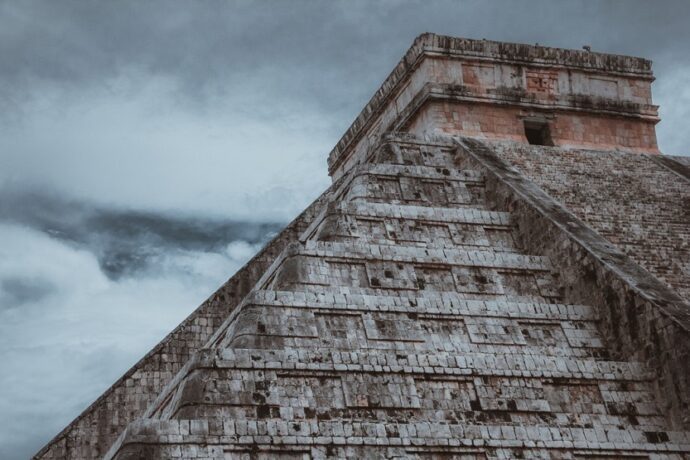
Sin comentarios